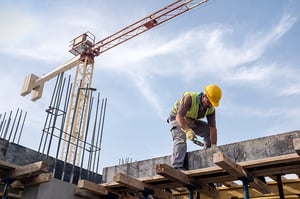Thousands of worksites will join the Occupational Safety and Health Administration (OSHA) and its partners for the sixth annual National Fall Stand-Down to prevent falls in construction. During the week of May 6-10, employers and workers will make it a point to identify and eliminate safety issues, review OSHA compliance initiatives and implement industry best practices to prevent work-related injuries and illnesses.
OSHA dedicates resources to preventing falls in construction because a lack of proper fall protection is the most frequently cited OSHA violation in the United States. FrankCrum’s Risk Management Team helps employers create strong safety and health programs by providing tools, resources and deep industry knowledge. But safety programs are not achieved overnight. Creating a safety culture where worker safety and health is a priority everyday is the only way to prevent injuries.
Here are some tips from the FrankCrum experts for preventing falls in construction.
Preventing Falls from Rooftops
Personal protective equipment is required for any employee working on a roof of any other work area where the distance to the ground or another surface is more than six feet. Roofing slide guards are not considered fall protection. If the fall arrest equipment looks like it needs repair, remove it from service and have it examined. Permanent anchorages can be installed during roofing operations and left in place after construction is complete. They must support 5,000 pounds for each employee who is attached by lanyard or lifeline.
Preventing Falls from Scaffolding
- Provide an access ladder.
- Use only scaffold-grade lumber.
- Install guardrails and toeboards on all scaffolding 10 or more feet above the ground.
- Ensure the scaffold is able to support four times the maximum intended load (including the weight of the scaffold).
- Confirm the scaffold is level by using screw jacks on base plates and mudsills.
- Keep scaffold within 14 inches of the building.
Preventing Falls in Residential Construction
Residential construction employers should ensure that employees working six feet or more above lower levels use guardrails, safety nets or personal fall arrest systems. A personal fall arrest system may consist of a full body harness, a deceleration device, a lanyard and an anchor point.
OSHA allows the use of an effective fall restraint system in lieu of a personal fall arrest system. To be effective, a fall restraint system must be rigged to prevent a worker from reaching a fall hazard and falling over the edge. A fall restraint system may consist of a full body harness or body belt that is connected to an anchor point at the center of a roof by a lanyard of a length that will not allow a worker to physically reach the edge of the roof.
Preventing Falls from Ladders
- Teach employees to step on and off ladders carefully
- Ensure they maintain three-point contact – one hand and two feet, or two hands and one foot – when climbing any ladder and when working from a straight or extension ladder.
- Train them to use a tool belt, backpack, hoist, lift, or ropes to carry tools and equipment, so their hands are free to grip their ladder.
- Do not allow employees to step or stand any higher than the step or rung specified on the manufacturer’s label.
- Have employees climb down before repositioning a ladder.
For more FrankCrum Toolbox Talks on preventing falls and other workplace accidents, click here.





